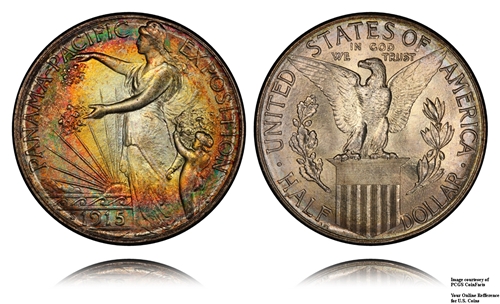
The 1915 Pan-Pacific Half Dollar
In order to celebrate the completion of the Panama Canal and the linking of the Atlantic and Pacific Ocean, an international exposition was to be held in 1915 in California. The Exposition was authorized in 1913, but the legislation authorizing the commemorative coins to be struck and sold at the exposition was later in coming, much later.
Two coinage bills were introduced in 1914 and they slowly worked their way through the legislature. One of them called for a half dollar, gold dollar, quarter eagle, and two quintuple eagles to commemorate the Canal and the Exposition. The other, sponsored by Nobel Peace Prize Laureate Senator Elihu Root was for a quarter dollar to commemorate a century of Peace. Somehow Senator Root seems to have forgotten about the Mexican American war of 1848, the Civil War, and the Spanish American War of 1898. Fortunately some others seemed to know the difference between peace and war and the quarter dollar bill quietly died. The first bill was finally passed and signed into law on January 16th 1915.
This gave the Mint a problem because the bill called for the coins to be struck and ready for distribution when the Exposition opened. That would be February 20th 1915, just over a month away. Fortunately the Mint had not been idle and had already been considering who would design the new coins. Requests for designs went out immediately to Robert Aikens for the quintuple eagles, Mrs. Evelyn Longman for the quarter eagle, Charles Keck for the gold dollar, and Paul Manship for the half dollar. Mint engravers Charles Barber and George Morgan were also asked to prepare designs just in case one of the outside designs was determined to be unacceptable. (From this point on we will just look at the half dollar, the other coins will be covered in the following series of articles.)
The Mints back up plan turned out to be a good one. Paul Manship’s design was received and reviewed by the Commission of Fine Arts January 29th and approved February 1st, but Treasury Secretary McAdoo and Assistant Secretary Malburn both thought the design was poor. On February 12th Barbers design was received and Manship’s design officially rejected.
Barbers obverse showed a standing figure of Liberty scattering flowers upon the waters of the Golden Gate looking out to a setting sun in the Pacific. The flowers were from a cornucopia being held by a cherub standing behind her. Pan-Pacific Exposition curves around the rim and the date is at Liberty’s feet. On the reverse the original design had an eagle reminiscent of the eagle on Morgan’s dollar perched on a shield of the arms of the United States. On either side of this was a dolphin to symbolize the two oceans joined by the canal. UNITED STATES OF AMERICA is around the top rim while HALF DOLLAR is along the bottom. The Motto IN GOD WE TRUST is in two lines above and beside the eagle’s head. This would be the first use of the motto on a commemorative coin.
Barbers design was approved but Secretary McAdoo did not like the dolphins and requested their removal. (Thus removing any reference to the canal being commemorated.) Barber quickly prepared two alternate versions; one with the dolphins removed and one with them replaced by oak and olive branches. The design with the branches was officially accepted on March 5th. (You will notice they have already missed the Feb 20th deadline.)
Even with the dies for the half dollar being made in house at the Philadelphia Mint the dies were not ready for shipping to California until approximately April 27th. But they had to be recovered from the shipper and returned to the Mint when it was realized that since they had been made without the S mintmark. It was originally thought to be unnecessary since all the coins were to be struck in San Francisco. But the Director realized that people unfamiliar with the authorizing legislation might believe they were struck in Philadelphia. So five pairs of new dies with the mintmark were made and shipped to California on May 3rd.
While the Mint had an exhibit with a coining press at the exhibition, all 60,000 half dollars struck of the 200,000 authorized were actually struck at the San Francisco Mint, making this the first commemorative coin struck at a branch mint. Sales of the half dollar at $1 each were not especially brisk, and by the close of the Exposition on December 4th only 27,134 had been sold with the balance being returned for melting.
There are only two major varieties of note for this coin. One of them has a clearly repunched S mintmark, and the other is a trial piece struck at Philadelphia with one of the no mintmark dies before they were “shipped out” on April 27th. Four copper trials, six silver, and two gold pieces were struck.